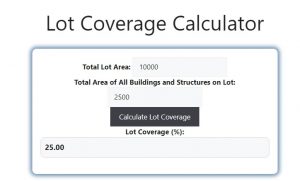About Lot Coverage Calculator (Formula)
The Lot Coverage Calculator is a useful tool for determining the percentage of a property covered by structures, such as buildings or houses. This is an important metric used in urban planning, zoning laws, and construction to ensure proper land usage and compliance with regulations. Understanding lot coverage helps property owners and developers know how much of their lot remains available for landscaping, parking, or future expansion.
Formula
The formula for calculating lot coverage is:
Lot Coverage = (Total area of all building footprints on a lot / Total area of the lot) x 100
Where:
- Total area of all building footprints: The combined footprint area of all structures on the lot.
- Total area of the lot: The overall size of the property or land in question.
How to Use
- Measure the building footprints: Calculate the total area occupied by all structures on your lot. This includes the main building, garages, sheds, and any other permanent structures.
- Find the total lot area: Measure the full size of your lot, typically recorded in square feet or meters.
- Input the values: Enter the total building footprint area and the total lot area into the calculator.
- Click Calculate: The result will show the percentage of the lot covered by buildings.
Example
Suppose you own a lot that is 10,000 square feet, and the total area covered by buildings (house, garage, and shed) is 2,500 square feet. Using the formula:
Lot Coverage = (2,500 / 10,000) x 100 = 25%
This means 25% of the lot is covered by structures, leaving 75% available for other uses such as gardens or parking.

FAQs
- What is lot coverage?
Lot coverage refers to the percentage of a lot that is occupied by buildings or structures. - Why is lot coverage important?
Lot coverage is crucial for complying with zoning regulations, ensuring proper land usage, and maintaining balance between green space and structures. - What buildings count towards lot coverage?
Any permanent structure, including homes, garages, sheds, and any other buildings, counts towards lot coverage. - Does a patio count as lot coverage?
Generally, uncovered patios do not count as lot coverage, but covered patios or structures may be included depending on local regulations. - How can I reduce lot coverage?
You can reduce lot coverage by downsizing structures, using multi-level buildings, or incorporating more open space in your design. - What’s the maximum lot coverage allowed?
Maximum lot coverage varies by location, and zoning regulations typically set limits, often around 40% to 60%. - Can lot coverage affect property taxes?
In some cases, increased lot coverage due to larger structures may influence property value and taxes, depending on local assessment rules. - Does landscaping count toward lot coverage?
Landscaping, open lawns, and other non-structural elements generally do not count toward lot coverage. - How does lot coverage impact drainage?
Higher lot coverage can lead to more impervious surfaces, which may affect water drainage and require additional planning for stormwater management. - Can I increase lot coverage with a variance?
In some cases, property owners can apply for a variance to exceed the allowed lot coverage, but this depends on local laws and approval processes. - What are lot coverage limits for commercial properties?
Commercial properties often have different lot coverage regulations compared to residential properties, depending on the type of business and zoning laws. - Do balconies or decks count toward lot coverage?
Balconies and decks may or may not count, depending on whether they are covered or enclosed. Local regulations should be consulted. - Can lot coverage influence home resale value?
Yes, homes with better usage of lot space, maintaining a balance between building size and outdoor areas, may be more appealing to buyers. - Is lot coverage the same as floor area ratio (FAR)?
No, lot coverage measures the building’s footprint on the lot, while floor area ratio (FAR) includes total building floor area compared to the lot size. - Does a swimming pool count as lot coverage?
Swimming pools may not count toward lot coverage in many cases, but pool houses or covered areas adjacent to pools likely will. - Can lot coverage affect future building permits?
Yes, exceeding allowable lot coverage may prevent you from obtaining permits for additional structures. - Do temporary structures like tents affect lot coverage?
Temporary structures generally do not affect lot coverage calculations, but permanent structures such as sheds or gazebos do. - Can lot coverage be different for different zones in a city?
Yes, lot coverage rules may vary based on zoning categories, with residential, commercial, and industrial areas having different restrictions. - How can I check my lot’s coverage limit?
You can check your local zoning regulations or consult with city planning offices to find out your lot’s coverage limit. - What happens if my lot exceeds coverage limits?
Exceeding lot coverage limits could result in fines, denied building permits, or required modifications to bring the property back into compliance.
Conclusion
The Lot Coverage Calculator is an essential tool for homeowners, developers, and urban planners to determine the percentage of land covered by structures. By calculating lot coverage, you can ensure compliance with local zoning laws, balance green space and built-up areas, and make informed decisions about property development.